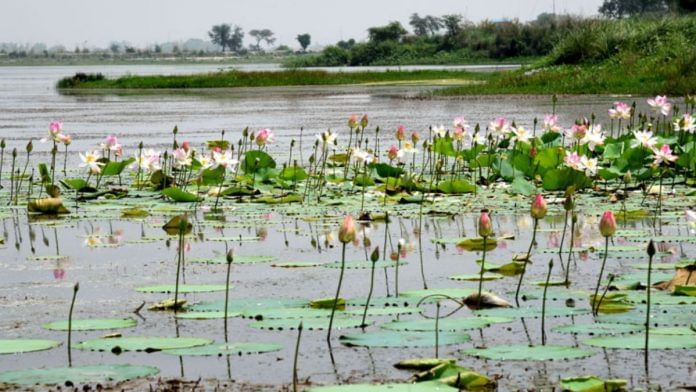New Delhi: Oases of nature can exist even in a city like Delhi, where dump yards taller than the Qutub Minar tower over settlements and hazardous air hangs like a veil.
And Delhi-NCR has seven such havens, said CR Babu, professor emeritus at Delhi University’s Centre for Environmental Management of Degraded Ecosystems at a lecture at the India International Centre Monday.
The seven biodiversity parks are sprawled across 3,000 acres with hundreds of rare and endangered species. These are no ordinary parks—they are spaces designed primarily to be habitable for native flora and fauna and improve ecosystem delivery. Human recreation is secondary.
Achieving this in NCR was no easy feat. Scientists who toiled to bring these parks to life showed the audience how, over a span of 20 years, barren patches of land were revived to hold trees, replenish groundwater, and bring back animals that were considered to be locally extinct.
This long-drawn labour continues to bear fruit.
“Last month we observed the first perching record of the Eurasian Griffon vulture in Delhi,” said Shah Hussain proudly, scientist-in-charge of the Aravalli Biodiversity Park, which falls between Delhi and Gurugram. He showed the audience a photo of the tall bird nestled between hard rocks and dried grasslands. “Though it is a migratory bird, it has found a suitable habitat here.”
According to Prof Babu, Delhi’s success with nurturing biodiversity parks has caught the attention of other states. Visiting these parks is also on the agenda of six foreign delegates who are in the city for the G20 deliberations.
Also Read: ‘Reimagine’ conservation – Study proposes preserving biodiversity alongside human aspirations
Listening to the soil
Babu’s association with Delhi’s biodiversity parks goes back to 2002 when the first two were conceptualised by then-lieutenant governor Vijai Kapoor. The Yamuna Biodiversity Park in Wazirabad was the first to open, followed by the Aravalli Biodiversity Park in 2005. Both parks and all the others since have been developed in conjunction with the Delhi Development Authority (DDA).
“How do ecosystem processes take place? How does a trophic structure come together? How does energy flow into the system? Creating a biodiversity park is not about plantations. Not at all,” said Faiyaz Khudsar, in charge of the Yamuna Biodiversity Park.
When his team started restoration efforts along the Yamuna’s floodplains, they were confronted with briny, silty land that was incapable of sustaining plantations. “So we listened to what the soil had to say,” Faiyaz said.
Existing plant species, however sparse, suggested the area was rich in groundwater, and that the landmass was perhaps a wetland that had been inundated with silt. And so Faiyaz switched gears and focussed on removing silt and reviving the wetland, which now hosts a rich variety of grasses and legumes that could never have survived the brine.
Along the ridges of the Aravali, the invasive monoculture of Prosopis juliflora was carefully removed and replaced with native species that have since taken root. Inactive floodplains have been restored to hold water, and with it, elusive animals like the small Indian civet, jungle cat, and leopard have returned. In the Aravalli Biodiversity Park, nilgai and jackals now roam.
Faiyaz’s data shows that the seven biodiversity parks have recharged over a million gallons of water since the monsoon of 2021, and four have impounded over a thousand million gallons.
“That’s Rs 2,000 crore worth of water,” Babu chimed in.
Also Read: India among 190 nations to agree to ‘historic’ framework to ‘halt & reverse’ biodiversity loss
Monetary value of the parks
So, what is the value of a biodiversity park? It could cross tens of crores if all the ecological services it provides are to be monetised.
Yamini Gupt, professor of finance and business economics at Delhi University, conducted a survey to determine the amount of carbon dioxide sequestered in trees, soil, and shrubs; runoff water preserved; and pollution avoided on account of the Aravalli Biodiversity Park. The study, which is ongoing, also seeks to determine the economic value of these services in terms of the human benefits derived.
“The idea of putting a monetary value to this is to ensure trees are given the care and attention they deserve,” she said.
From a tiny sample size of a little over two acres, 829 trees surveyed were able to store 37.36 tonnes of carbon dioxide worth over Rs 5 lakh, Gupt said. This small plot of land avoided 455 cubic feet of runoff and removed 0.06 tonnes of air pollution. If these results are extrapolated over 500 acres, the monetary value of these services crosses Rs 11 crore, her research suggested.
“But we know our sample size is too small right now. We started this work in January, and hope to have a more substantial sample size by monsoon,” she said.
Much remains to be done with the parks, which, as one audience member pointed out, are overrun with manmade structures like temples. Other parts continue to languish under the dominance of invasive species or encroachments.
“This has been a wonderful presentation, but I think we need to think bigger. Why can’t we turn the whole Yamuna floodplain into a biodiversity park? It’s the only stretch of land that will allow it in this city. What’s stopping us?” another audience member asked as the lecture came to a close.
(Edited by Theres Sudeep)



